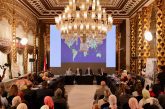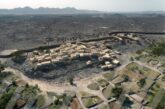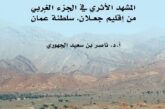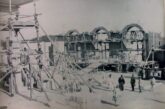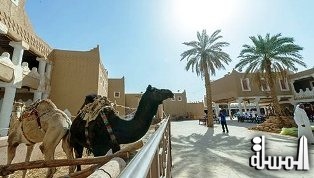
On World Heritage Day, Saudi Heritage testifies to a qualitative transformation
aTP- Arab tourism portal- On Monday the world will celebrate World Heritage Day which falls on the 18th of April of every year. The purpose behind it is to call for the protection of human heritage, bring awareness to it, as well as shed light on the efforts put forth by all relevant authorities and organizations.
This year’s World Heritage Day coincides with a monumental achievement realized by national heritage in Saudi Arabia reflected in the tribute made in the concluding statement of the Islamic Summit held in Istanbul, Turkey last Wednesday and Thursday. The tribute was for Saudi Arabia to have founded a program named after the Custodian of the Two holy Mosques concerned with urban heritage, as well as the establishment of a center concerned with built heritage devoted to the preservation and rehabilitation of built heritage by SCTH.
The name of Saudi Commission for Tourism and Antiquities was recently changed to Saudi Commission for Tourism and National Heritage, so as to include the elements and components of heritage. A resolution was also issued for the preservation of Islamic heritage sites and the Antiquities, Museums and Built Heritage Law was passed as well as its executive bylaws.
This tribute was made by leaders of the Islamic World in the concluding statement of the summit emphasizing the significance of the National Heritage Program adopted by SCTH and its role concerning built heritage which is considered an essential component of this country’s identity and the historical and cultural status it holds given its stands on successive civilizations that have contributed to building human civilization headed by the Islamic civilization.
The tribute made at the summit highlighted the drastic change witnessed by Saudi Arabia in the field of national heritage at the hands of SCTH which has influenced a drastic change concerning the views on heritage and how the government and local communities handle heritage. This has contributed to the issuance of a number of resolutions and regulations and the establishment of a number of heritage projects all over Saudi Arabia.
A matrix of programs and projects for the rehabilitation of heritage
By World Heritage Day, SCTH has achieved a significant change in the field of national heritage by issuing a number of regulations, notably the Antiquities, Museums and Built Heritage Law approved by Saudi last year. Saudi also issued a number of Royal Decrees concerned with the protection of heritage sites prohibiting any infringement on them. It also approved the National Built Heritage Project, and the establishment of the Saudi Heritage Hospitality Company. The government went on to register four sites into the UNESCO World Heritage List. It also established a group of new museums, heritage village projects, and many more achievements. In addition, a resolution was passed by the Ministerial Council recently changing the name of SCTH to Saudi Commission for Tourism and National Heritage in line with its expanding tasks in the field of heritage.
National Built Heritage Program
The National Built Heritage Program, issued by Royal Decree No. 28863 dated 21/7/1435, is a significant historic national project that will significantly impact and effectively change national built heritage programs and projects.
The program was originally approved by King Abdullah Bin Abdulaziz (may he rest in peace), and was re-approved, confirmed and expanded by the Custodian of the Two holy Mosques, King Salman Bin Abdulaziz.
HRH Prince Sultan Bin Salman Bin Abdulaziz, President of SCTH has adopted this project and continued with the details concerned with the preparation of this program as a national priority and its close association with the national brand and promoting social responsibility, as well as economic significance given the fact that the heritage sector is a promising economic field. The program also highlights the Islamic and Arabian brand and Arabia as their source. Saudi Arabia is proud of its Arabism and its religion of Islam and the fact that it is located at the crossroads of civilizations and the birthplace of Islamic and Arabian Civilizations.
The program, implemented by SCTH in collaboration with a number of public agencies, aims to achieve protection, knowledge, awareness, attention, rehabilitation, and development of national cultural heritage components, making it an integral part of the life and memory of nationals. It also emphasizes pride and utilizes it in the everyday culture of the community. It also seeks to link nationals to their homeland by turning heritage into an experience, and drastically changing how it is cared for.
The program focuses on the efforts and programs related to raising social awareness on built heritage, so as Saudis can better identify their national heritage and its historic elements. The program seeks to have them live among these sites and relate to them not just read about them in books. This is exactly what the Custodian of the Two Holy Mosques emphasized in the 45th BoD Assembly of The King Abdulaziz Foundation. He spoke about the efforts in raising awareness on heritage and the impact that has on the livelihood of the youth of this nation, the significance of knowing about the how this nation was founded and unified, and how he himself, his father and forefathers were all a part of the unification of this blessed nation that remains and will continue to be strong and gallant.
The program also aims to redirect interest in the national treasures and heritage of this nation and present it to Saudis so they can experience it first hand and gain knowledge of these extensive riches and the succession of civilizations taking place on this land, so as to revive these sites thereby increasing their sense of belonging and patriotism.
The program includes more than 71 projects within the fields of antiquities, museums, built heritage and handicrafts, as well as other projects funded and implemented by SCTH stakeholders which also fall under this project.
The program includes 10 tracks which are interest in sites of Islamic history, development, rehabilitation, and equipping of museums and archaeological sites in various provinces and regions, operation and maintenance of museums and archaeological sites, preservation of built heritage sites and development of traditional villages, registration and protection of antiquities and archaeological research and excavations, programs and activities by museums and archeological sites, development of handicrafts, raise awareness on national heritage, attract and develop necessary cadre for the management of national heritage, and cultural heritage events.
SCTH has adopted a number of significant projects and programs within the framework of this project: media awareness of national heritage, antiquities and heritage projects, built heritage and handicrafts projects, as well as the repatriation of national antiquities locally and abroad. SCTH is currently collaborating with the World Bank and both the UNWTO and UNESCO to prepare a comprehensive study the economic impact of the national heritage programs and projects in Saudi Arabia.
Many of the projects are expected to be accomplished over the next four years under the National Cultural Heritage Program. Among such projects will be the opening of 18 museums in various provinces across Saudi Arabia, the rehabilitation of 56 archeological sites for visitations, the completion of some projects of the Saudi Heritage Hospitality Company, commence the implementation of major projects in partnership with other concerned public agencies and private sector. Such projects include Souk Okaz, and the completion of development in more than 26 heritage villages, and more than 300 distinctive heritage buildings, the completion of more than 269 ancient buildings and historic state palaces, as well as the opening of Turaif District in Historic Diriya which will be a significant addition to Saudi tourism, in addition to the completion of the Riyadh city center development project.
Antiquities, Museums, and Built Heritage Law
Of the major achievements related to national heritage was the issuance of the Antiquities, Museums, and Built Heritage Law by Royal Decree No. m/3 dated 9/1/1436, including an integrated matrix of provisions and rules for the regulation of national heritage, its protection, documentation, maintenance, and rehabilitation. The law also seeks to stimulate investment in national heritage and encourage its contribution in cultural and economic development. HRH SCTH President has issued a resolution approving the executive policies of the law in preparation of its implementation.
Changing SCTH’s Name
Ministerial Council resolution issued Tuesday 13 Ramadan 1436, approved the changing of the name Saudi Commission for Tourism and Antiquities to Saudi Commission for Tourism and National Heritage.
This came as a gesture of the government’s trust in SCTH and to meet Saudi aspirations in this national organization, which had always committed to the highest of performance standards and established administrative approach to government jobs since its inception. The Ministerial Council approval to change the name emphasizes the status of national heritage and the state’s interest in it as an authentic sector related to the nation’s history, and represents a cultural value to Saudi’s position in human history. The changing of the name presents SCTH with a new responsibility of shaping efforts of focusing interest in national heritage in the hearts of citizens, instilling patriotic values, and emphasizing the sense of belonging to this great nation.
Antiquities Log … National Memory for more than 7270 Archeological Sites
In recognition of the significance of Saudi’s national heritage, and the value of ancient treasures found all across Saudi. SCTH has benefited from its accumulative experience in in the employment of IT systems in servicing national antiquities, and transition to an electronic work environment to more efficiently document and manage national heritage sites. SCTH has therefore, developed a “National Antiquities Log” in 1432, which now includes more than 7270 archeology sites, and work is currently underway to complete the registration of the rest of the archeology sites.
34 Saudi and International Missions working in Archaeological Sites
SCTH has expanded in archaeological surveys and excavations taking on a more comprehensive approach including more sites, since it plays a major role in promoting Saudi’s cultural dimension through the discoveries made. SCTH carried out a lot of research programs and archaeological field work through specialized local and international teams using modern scientific methods of physics where SCTH implemented an archeological excavation and survey program across Saudi that resulted in the inventory and registration of thousands of archaeological sites. SCTH also manages 34 Saudi and International delegations participating in archaeological sites in collaboration with archaeological missions from France, Italy, United States of America, United Kingdom, Germany, Japan, Belgium, Poland, Finland, and Austria.
Repatriation of 17 thousands of antiquities locally and 30 thousand from abroad
In the context of SCTH’s interest in the repatriation of antiquities, HRH President of SCTH has launched the “Repatriation of National Antiquities” Campaign, in Muharram of 1433, under the patronage of the Custodian of the Two Holy Mosques King Abdullah bin Abdulaziz. SCTH’s efforts have resulted in the return of more than 17 thousand artifacts from within Saudi Arabia, and more than 30 thousand artifacts from abroad, some of which have been gone for more than 50 years. The campaign achieved great success and ended with the “Restored National Antiquities” exhibition, held by SCTH in 1433. SCTH continues its efforts to restore more antiquities locally and abroad in accordance with local and international regulations and agreements.
Registration of 4 Sites in the UNESCO World Heritage List
SCTH shows great interest in the registration the archaeological and heritage sites in the UNESCO World Heritage List, highlighting Saudi’s cultural dimension, the preservation of its national heritage, and introducing its historical value. Saudi sites were first registered into the list after the approval of the Ministerial Council Resolution in 1427 H to register three Saudi sites in the UNESCO World Heritage list: Mada’in Saleh, Historic Dirya, and Historic Jeddah. SCTH has worked on preparing and submitting the files of three sites to the UNESCO. Mada’in Saleh was the first Saudi site to be registered in the list back in Rajeb of 2008, it was followed by registering AlTairf district in Historic Dirya in 2014, and then Historic Jeddah was register in 2014.
The Royal Court has also approved the SCTH’s request to register the rock inscription site in Hail in the world heritage list. The site earned a unanimous approval and it was registered on Friday July 3, 2015, to be the fourth Saudi site in the world heritage site after Mada’in Saleh, Historic Dirya, and Historic Jeddah. SCTH is also working on registering 10 other sites in the coming years, and they are rock inscriptions of Hima wells, AlFaw Village in Riyadh, Ahsa Oasis, Egyptian Hajj Route, Levant Hajj Route, Zubaydah Trail, Hejaz Railway, Der’ District in Domat ElJandal, Thi Ain Heritage Village of Baha, Rijal Alma’a Heritage Village in Aseer.
Establishment and Development of Museums
SCTH set a strategy to develop the sector and so it tied the museums with the tourist tracks and activities across Saudi provinces. SCTH has established 5 regional museums in each of Dammam, Baha, Abha, Hail, and Tabuk. It is developing 6 existing museum in each of Taima, Najran, Jizan, Ahsa, Ula, and Jouf. This includes the development of buildings and museum exhibitions, in addition to the establishment of new museums and the development of existing museums.
SCTH also worked to utilize 15 archaeological and historic buildings that have been restored as museums in the provinces. STCH also supports private museums and qualifying them to practice museum activity and receiving visitors. SCTH has already granted licenses for 131 museums of total private museums subject to licensing standards. SCTH also organizes a forum for private museum owners held every two years in various provinces. It also organizes international trips for private museum owners to explore distinctive experiences in this field and exchange experiences.
Roads of Arabia Exhibition
SCTH is keen to initiate international cooperation with the world’s most famous museums in the fields of exhibition, exchange of experiences and trainings, rehabilitation of cadres, visits, studies and research, visitation programs for experts, and exchange staff. This is done through bilateral agreements for cooperation under bilateral agreements between Saudi Arabia and these countries. These efforts have led to the Roads of Arabia exhibition held at the Louvre. The exhibition went on to six more locations that were very successful starting at the Louvre and moving on to the La Caixa Foundation, Hermitage Museum in Russia, and then the Pergamon Museum in Germany. The expo then went on to a further five location in the United States. Royal approval has declared the continuation of the exhibition in a number of other countries.
The Establishment of the National Built Heritage Center
With the growing efforts in the field of built heritage and the importance of allocating a center to oversee the business and projects related to built heritage, SCTH has established the National Built Heritage Center (NBHC) in 2009, and has approved the institutional structure of NBHC and instituted built heritage departments in SCTH provincial branches.
NBHC has worked over the past years to implement a number of programs and projects related to built heritage, in addition to the organization the annual National Built Heritage Forum.
Resolutions to Protect the Built Heritage from Threats
The biggest risk threatening national built heritage before the establishment of SCTH was the random demolition of heritage buildings. Therefore, SCTH banned the random demolition when it first started working with built heritage. It coordinated with Ministry of Interior and MoMRA to stop random demolition of built heritage buildings. SCTH set standard and regulations governing just that, and a number of orders and circulars were issued to limit the demolition of heritage buildings, until after specialists from SCTH analyzed the case. SCTH conducted an initial nationwide field survey with the participation of local agencies and organizations in each province. About 2000 sites of the built heritage were calculated, between villages, neighborhoods, historic city centers, and buildings. Initial studies stated that more than 800 sites were viable for investment, and 173 sites were viable for investment at the moment. Because the built heritage sites in Saudi greatly exceed this number, SCTH is working to implement a comprehensive and detailed calculation in preparation for them to be classified in three categories and registered in the National Built Heritage Log. SCTH has developed criteria for the selection and classification of built heritage sites in accordance to international standards.
Initiatives and Programs for the Protection and Rehabilitation of Built Heritage
Within SCTH’s efforts to protect built heritage, it has developed a set of initiatives, projects, and programs and has sought their implementation with stakeholders from governmental and non-governmental agencies in various Saudi cities and provinces. The most prominent of these initiatives and programs: the rehabilitation and development of heritage villages and towns, a program to improve historic cities centers, a rehabilitation program for public historic buildings during the reign of King Abdulaziz, a rehabilitation program for built heritage along Red Sea ports, and a rehabilitation and investment program for privately owned distinctive built heritage buildings.
These programs include a number of projects partially funded by SCTH. They are also funded by other ministries, private sector, local communities, and lending funds as per procedures set by SCTH via cooperation agreements with other agencies.
SCTH has granted local communities and Tourism Development Councils in various provinces the key role in dealing with the requirements and tasks of built heritage i.e. protection, preservation, development and improvements, as well as site management, implementation of small enterprises and events and activities programs. A number of programs have been designed to stimulate and assist them in fulfilling their roles. Key programs are: Thameen, Takamul, and Tamkeen.
SCTH has supported these programs with an integrated plan to train and qualify national cadre in the scope of restoring and rehabilitating sites and built heritage buildings.
Islamic History Sites
Saudi shows great interest in Islamic History sites and their preservation. This is evident it the Royal Decree issued in 1429, prohibiting the vandalism of Islamic history sites in Makkah and Medina, and appointing SCTH with the calculation of such sites, and end all types of vandalism and infringement. SCTH took the initiative of establishing the ‘Islamic History Sites Program’ specializing in Islamic history sites associated with the Prophet’s mission, and the times of the Caliphs across all of Saudi. Two committees have been formed for the program: a steering committee and a consultative committee chaired by HRH SCTH President, and two members that are officials and specialists from various public agencies. A specialized committee was formed to calculate Islamic history sites in two provinces, and create lists of Islamic history sites in each. The field survey of Islamic history sites uncovered 384 sites, 266 of which are located in Medina and 118 are in Makkah.
Historic Mosques Program
SCTH BoD has agreed, in its recently held 39th meeting, to develop a ‘Historc Mosques Program’ at SCTH with the objective to coordinate with the Ministry of Islamic Affairs, Endowments, Da`wah, and Guidance, as well as a number of concerned agencies to preserve and rehabilitate historic mosques in Saudi, and highlight their religious, cultural and architectural values.
The creation of this program is but a milestone among many programs adopted by the Heritage Foundation over a span of 17 years, where many historic mosques have been restored and rehabilitated in Saudi provinces.
National Registry for Artisans
The National Handicrafts Development Program is the culmination of SCTH efforts in this field, it is also a regulatory framework for the practices of this vital sector. The program has worked through the National Registry of Artisans on a census for artisans working in this sector in Saudi. An estimation of artisan numbers was made based on field surveys carried out by the team for the National Strategy for the Development of Handicrafts of different regions, and most of the governorates and administrative centers in Saudi. Results found that there are 13021 artisans and craftsmen make up 63% of the total while craftswomen represent 37% of the total and number 7542. The program is working on a number of activities to support and develop handicrafts and artisans and support investment in this field.
Development of City Centers
Of SCTH’s many projects is the Development of City Centers which aims to preserve the urban identity of city centers, making them into tourist attractions, and develop them architecturally, socially, and tourism wise, as well as accomplishing sustainability. This is achieved via collaboration with provincial municipalities. City secretariats and municipalities support SCTH technically in the scope of national heritage preservation given they have allocated budgets for city center development. SCTH seeks to revive and rehabilitate the urban character distinctive to historic city centers making them into cultural and historic centers in the province.
SCTH has in collaboration with secretariats and municipalities developed a total of 6 city centers during 1435; Abha city center, Jazan city center, Najran city center, Tabuk city center, Hail city center, Majma’a city center. The program includes 20 projects and aims for an additional 10 project by the end of 1436.
SCTH began implementing the City Center Development Project in Safar 1435, and will continue for three years.
Saudi Heritage Hospitality Program
The Saudi Heritage Hospitality Company has laid the cornerstone for its very first project ‘Samhan Heritage Hotel in historic Direya. This is one of the most important tourism investment companies SCTH has worked on and was recently approved by the government. It is also one of the key projects for National Cultural Heritage Program, a new phase of state support and their interest in investing in built heritage sites emphasizing their importance in the national memory, and turn them into a productive economic sector.
The company was launched as part of the signing ceremony dated Sunday Rabea II, 1436 in collaboration with contributing agencies, such as: The Public Investment Fund, Taiba Holding Co., Dur Hospitality, Tayyar Development and Tourism Investment and Real Estate Company, Riyadh Development Company, Jeddah Development and Urban Development Co.



